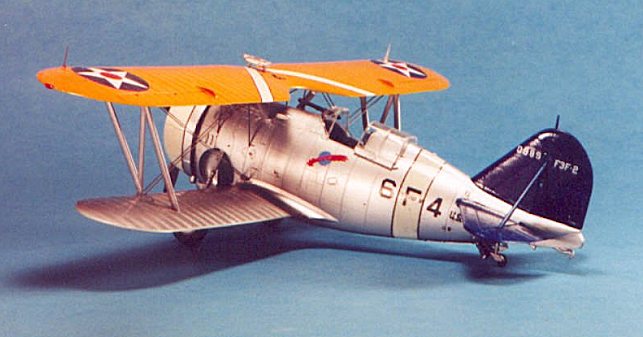
|
KIT # |
3414 |
|
PRICE: |
$37.50 |
|
DECALS: |
See review |
|
REVIEW : |
|
|
NOTES: |
|

|
HISTORY |
As the revolution in fighter aircraft that would result in the great fighters of the Second World War was beginning in the mid to late 1930s, the U.S. Navy was in a quandary: the biplane offered superb maneuverability and docile handling, which made deck operations safer than with the new monoplanes, but the biplane was outclassed in speed and likely armament. The Grumman F3F-1 had come onto operations with two naval and one Marine fighter squadrons, offering a substantial performance increase over the preceding Boeing F4B-4, but still not up to what the Bureau of Aeronautics knew the Army Air Corps and foreign air forces were developing. In an era when a big production run of naval aircraft was anything over 50, the Navy decided to experiment.
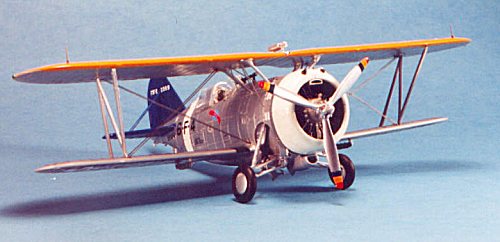 In 1936, just after the
introduction of the F3F-1, the Bureau of Aeronautics ordered the XF2A-1
monoplane from Brewster, and the XF4F-1 biplane from Grumman. The engineers at
Grumman knew the biplane was at a developmental dead-end, and the company was
not interested in working itself out of business. Leroy Grumman pointed out to
the Navy that, if the proposed engine for the XF4F-1, the Wright R-985, was
placed in the F3F airframe, the result would be a biplane fighter with
performance closely similar to that expected from the XF4F-1, and in an earlier
time frame. BuAer concurred: the result was the XF3F-2 - originally the last
F3F-1 - modified with new forward fuselage and powerplant, and soon a larger
rudder, with a resulting speed performance of 260 mph, 45mph faster than the
F3F-1. The airplane was ordered into production as the F3F-2, to complete the
updating of the fleet fighter squadrons. Grumman, as a result, was able to
convince the Navy to order the XF4F-2 monoplane fighter prototype, which would
go on to immortality as the Grumman "Wildcat" in the coming war.
In 1936, just after the
introduction of the F3F-1, the Bureau of Aeronautics ordered the XF2A-1
monoplane from Brewster, and the XF4F-1 biplane from Grumman. The engineers at
Grumman knew the biplane was at a developmental dead-end, and the company was
not interested in working itself out of business. Leroy Grumman pointed out to
the Navy that, if the proposed engine for the XF4F-1, the Wright R-985, was
placed in the F3F airframe, the result would be a biplane fighter with
performance closely similar to that expected from the XF4F-1, and in an earlier
time frame. BuAer concurred: the result was the XF3F-2 - originally the last
F3F-1 - modified with new forward fuselage and powerplant, and soon a larger
rudder, with a resulting speed performance of 260 mph, 45mph faster than the
F3F-1. The airplane was ordered into production as the F3F-2, to complete the
updating of the fleet fighter squadrons. Grumman, as a result, was able to
convince the Navy to order the XF4F-2 monoplane fighter prototype, which would
go on to immortality as the Grumman "Wildcat" in the coming war.
With the slightly-modified F3F-3 that would follow the F3F-2 into production to provide enough fighters for all seven prewar carrier fighter squadrons, this was the last order for the biplane fighter by the U.S. Navy. The airplanes gained a modicum of fame when they starred in the Hollywood Technicolor epic, "Dive Bomber." Ostensibly the stars were Errol Flynn and Fred MacMurray, but over the years it has become the airplanes - photographed in the last pre-war summer in which naval aircraft would appear in the classic "golden wings" markings - that are seen as the stars. I highly recommend this movie, which is available on VHS for US$19.95, restored to its pristine Technicolor deep-saturated glory, starring the F3F-2s, SB2U-2s and TBD-1s of VF-6, VS-6 and VT-6.
|
THE KIT |
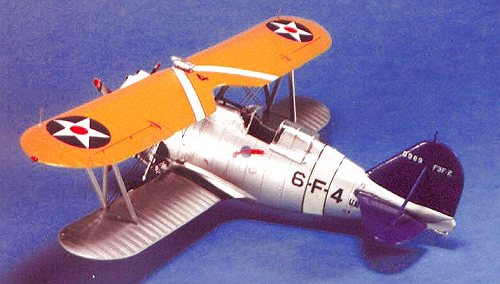 Anyone who has peeked
inside the box of the preceding F3F-1 kit knows what is inside: one of the
cleanest, sharpest injection molded plastic kits ever produced. The F3F-2 kit
differs from its predecessor with a different engine, 3-bladed prop, cowling,
forward fuselage, cockpit canopy, and rudder. As with the F3F-1, the large decal
sheet provides numbers, designators, squadron insignia, etc., to allow the
modeler to make any one of the 62 F3F-2s produced.
Anyone who has peeked
inside the box of the preceding F3F-1 kit knows what is inside: one of the
cleanest, sharpest injection molded plastic kits ever produced. The F3F-2 kit
differs from its predecessor with a different engine, 3-bladed prop, cowling,
forward fuselage, cockpit canopy, and rudder. As with the F3F-1, the large decal
sheet provides numbers, designators, squadron insignia, etc., to allow the
modeler to make any one of the 62 F3F-2s produced.
The boxart model is the F3F-2 flown by then-1st Lt. Robert E. Galer of VMF-2, which he ditched in the Pacific in November 1940 as a result of engine failure while in the landing pattern for carrier qualification on the USS "Saratoga." This airplane was raised in the early 1980s, found to be in good condition, and restored to original condition as the only original F3F-2 left (the other three flying F3F-2s being modern reconstructions using just enough parts from three wrecked airframes to meet to requirements for being licensed as "F3F-2" aircraft). Galer's airplane is now in the National Naval Aviation Museum in Pensacola.
|
CONSTRUCTION |
As with any Accurate Miniatures kit, the modeler should take the radical step of actually following instructions and assembling the kit according to the procedure outlines. These kits have been built several times by various modelers, and the procedures outlined are definitely the best way to go about it.
The only real difficulty is still with the attachment of the landing gear. Rather than fiddle with it as the instructions state, the modeler can solve the entire problem by simply widening the slot at the rear of Part 13, which will allow the assembly to slip into position easily.
By taking my time and following the instructions, I found that I needed no putty whatsoever during the construction of this model.
|
PAINT & DECALS |
Painting:
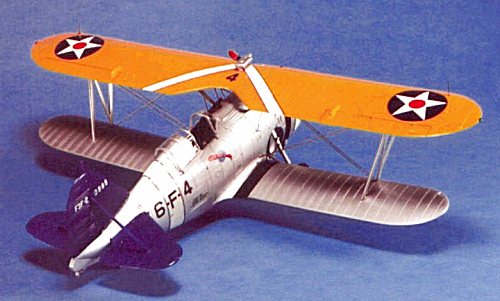 I painted the cockpit per
the instructions prior to assembly, using Testor's Aluminum Plate (left unbuffed)
as the Aluminum lacquer the cockpit was painted in, with some touches of Gunze
Sanyo "Gloss Red" and "Gloss Yellow" on various switches,
with the instrument panel painted "Metallic Black Gloss." The
photo-etch seatbelt was painted "Sail Color."
I painted the cockpit per
the instructions prior to assembly, using Testor's Aluminum Plate (left unbuffed)
as the Aluminum lacquer the cockpit was painted in, with some touches of Gunze
Sanyo "Gloss Red" and "Gloss Yellow" on various switches,
with the instrument panel painted "Metallic Black Gloss." The
photo-etch seatbelt was painted "Sail Color."
The upper wing was painted Gunze Sanyo "Orange Yellow Gloss," which is closer to the color the Navy actually used for their "golden wings" than the incorrect "Chrome Yellow" too many modelers use, not knowing this is an Army color.
Once I had assembled the fuselage, I painted the tail surfaces Tamiya "Blue Gloss," lightened just a bit with Tamiya "Gloss White," and painted the cowling and fuselage band with "Gloss White," since I had decided I was going to make the aircraft of the second section leader in the Enterprise's VF-6. I painted the lower surface of the upper wing and the lower wings with SnJ "Aluminum," to represent the aluminum-doped fabric surfaces. The fuselage, interplane struts, and landing gear were all painted with Testor's Aluminum Plate, left unbuffed and then sealed with Metalizer Sealer, to represent the aluminum lacquer-painted metal surfaces. I did polish out the front surfaces of the propeller blades.
Decals:
I used the kit decals to make BuNo 0989, 6-F-4, of VF-6. This airplane is one of the best-known F3F-2's due to the fact it is the airplane that Fred MacMurray "crashed" in the movie "Dive Bomber." The decals went down with a little help from Micro-Sol, with no problems.
Final Assembly:
Following instructions, I attached the upper wing to the cabane struts, attached the interplane struts to the upper wing, then attached the lower wings to the fuselage and interplane struts, all with no problem. I then attached the wheels and prop, the telescopic gunsight, and the cockpit canopy in the open position. When all this had set up, I took the photo-etch rigging and popped it into place, making certain everything stayed where it should with a judicious drop of cyanoacrylate where necessary. I used nylon repair thread for the radio antenna wires.
|
CONCLUSIONS |
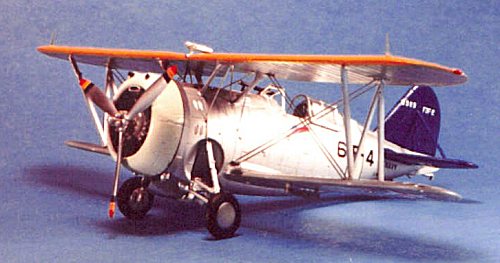 I've been a fan of the
F3F series ever since I found the autobiography of a naval aviator who had flown
in the late 1930s, in the school library at age 10. He loved that airplane, and
the painting on the endpapers looked very good. This model looks every bit as
good as that painting. I have the good fortune to spend a few hours every month
around one of the flying F3F-2s at the Planes of Fame Museum in Chino, and this
model looks like someone went out and hit the 1:1 with shrink spray.
I've been a fan of the
F3F series ever since I found the autobiography of a naval aviator who had flown
in the late 1930s, in the school library at age 10. He loved that airplane, and
the painting on the endpapers looked very good. This model looks every bit as
good as that painting. I have the good fortune to spend a few hours every month
around one of the flying F3F-2s at the Planes of Fame Museum in Chino, and this
model looks like someone went out and hit the 1:1 with shrink spray.
For anyone who has thought of doing a biplane but been put off by the alleged difficulty of aligning the wings and adding the rigging, this kit practically does those items for you itself. This is an "assembler" in the best sense of the word; the result is a museum-quality model right out of the box.
|
REFERENCES |
SS1160: Rich Dann, "Grumman Biplanes In Action," Squadron Signal Pubs.
Copyright ModelingMadness.com. All rights reserved. No reproduction in part or in whole without express permission.
If you would like your product reviewed fairly and fairly quickly, please contact the editor or see other details in the Note to Contributors. 2022